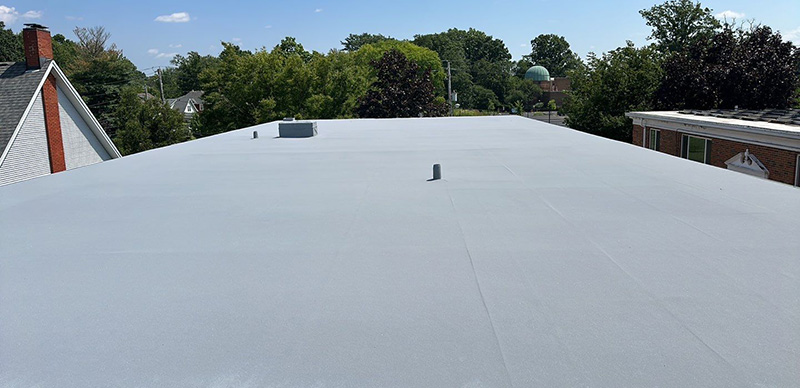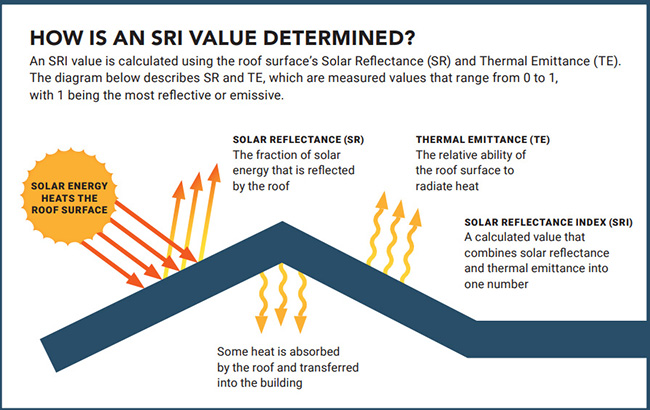Summary: The official R-value of silicone roof coatings is negligible, or close to 0. However, they increase energy efficiency by adding reflectivity, lowering roof temperature, and making HVAC units not work as hard.
So, you want to install a silicone roof coating system over your existing roof.
Great choice!
As you probably know, coating systems can get your roof under a new (and renewable) warranty. Plus, you’re minimizing (or completely avoiding) a tear-off, which is good for numerous reasons.
But if you’re trying to increase R-value, silicone coatings won’t get it done. According to the SPFA (Spray Polyurethane Foam Alliance), silicone has an official R-value of “negligible.” This basically means that some R-value is there, but it’s less than R-1.
However, there are other ways coatings influence energy efficiency; they are:
- Lowering roof temperature
- Reducing HVAC usage
We’ll explain each point in more detail below.
And just so you’re aware, West Roofing Systems has been installing spray foam and coating commercial roofing systems since 1979. Coating systems on their own have been popular since around 2008.
Let’s get started.

Lowering roof temperature
Silicone roof coatings lower your roof temperature in a few ways. One is the color. Usually it’s installed in a white or light grey color.
You might wonder, if a building owner had a choice between “white” or “light grey,” why would they even consider the grey color? A white roof will reflect the sun better than a grey roof.
Well, in the Midwest, all four seasons are of equal length.
There’s an equally long Summer and Winter.
While a white roof would be better at reflecting the sun than a grey roof in the Summer, it’ll have the disadvantage of NOT absorbing the sun in Winter.
In the Winter, the sun on the roof is a good thing.
Keeping the roof temperature higher in the Winter reduces heating costs. It also helps to thaw snow and reduce freezing water.
The other way silicone roof coating systems reduce roof temperature is through their SRI (Solar Reflectance Index).
Basically, it’s their ability to reject solar heat.
SRI is calculated by combining solar reflectance and thermal emittance into one number:

Source: https://coolroofs.org/documents/CRRC-SRI-Document_2022-07-12.pdf
The higher the ability to reject solar heat, the lower the roof temperature.
Reducing HVAC usage
When you add coatings, the roof surface temperature will drop (depending on what’s already on your roof.)
When this happens, your HVAC unit won’t have to work as hard to maintain a comfortable temperature inside your building.
On a 90-degree day, a conventional (darker-colored) roof could be as hot as 150 degrees. On a “cool” roof, the temperature on the same roof could be around 100 degrees.
A 50-degree difference.
Heat transfers from the roof through insulation and into your building.
With a 50-degree head start, a cool roof will bring cooler air into your building. Cooler air = less reliance on HVAC units to maintain a comfortable temperature.
With your HVAC unit not working as hard, your energy bills could be reduced.
So, while roof coatings don’t have an R-value, they can still reduce energy costs.
This video from the U.S. Department of Energy explains the difference in roof temperature with/without a roof coating system:
Extra Note: Another factor to consider is that when your HVAC doesn’t work as hard, it won’t need to be maintained or replaced as often. It’s like a 50-mile commute to work is cut in half. Less mileage = fewer oil changes, tire replacements, gas, etc.
Conclusion
Hopefully you’ve learned that although silicone roof coating systems have no R-value, they positively influence energy efficiency.
Here are some other articles you may be interested in:

